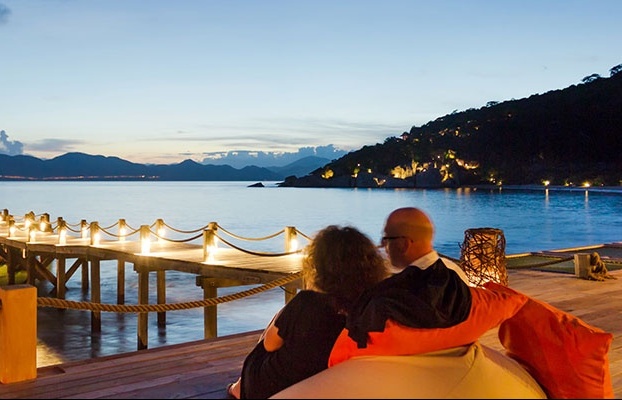Northwestern provinces boost links for sustainable tourism development
 |
| Visitors to a community-based tourism village in Mai Chau district of Hoa Binh province |
To fully tap potential, the region’s provinces of Hoa Binh, Son La, Lai Chau, Dien Bien, Phu Tho, Lao Cai, Yen Bai and Ha Giang have enhanced links for sustainable tourism development.
Since the eight provinces signed a tourism cooperation agreement in 2008, they have focused on building infrastructure facilities, restoring cultural and historical sites, and traditional craft villages, preserving and promoting the values of cultural and geographic heritages and natural landscapes, and building new tourism products.
Through the cooperation programme, many tourism products of the localities have been included in travel agencies’ package tours, becoming attractive to tourists.
The region’s tourism development cooperation has yielded substantial outcomes, with visitor numbers increasing year on year. In 2016, the number of tourists to the eight provinces reached nearly 18 million, up 11.8 percent over the previous year. Of the total, 6.4 million were overnight visitors, including 1.2 million foreigners, an increase of 11 percent.
In the first half of 2017, the region welcomed 13.6 million holidaymakers and earned 10.1 billion VND in tourism revenue, 80 percent and 70 percent of yearly goals, respectively.
However, besides these encouraging results, there remain obstacles hindering regional tourism development including difficult terrain, poor infrastructure and limited resources, according to insiders.
The region lacks high-class tourism services to keep tourists longer, they said, adding that promotion has also been poor, with few travel firms operating in the region.
Therefore, the provinces should hunt investment in tourism and road infrastructure, they suggested.
They also agreed on the need for more human resources training, the most serious problem facing the provinces’ tourism, as 60 percent of local tourism workers have no professional training.
Home to more than 30 ethnic minority groups, the region should focus on developing community-based tourism to introduce tourists to the beauty of the people, cultures and lifestyles of local ethnic minorities, they said.
Over the years, northwestern provinces have tried to create the best conditions for different economic sectors to invest in tourism. Transport infrastructure works serving tourism have been built, including the Noi Bai-Lao Cai Expressway, National Highway 6, and a railway linking Lao Cai and Kunming (China).
Luu Duy Linh, Deputy Director of the Hoa Binh provincial Department of Culture, Sports and Tourism, said regional provinces have already developed a road tourism route, National Road 6, connecting Hanoi, Hoa Binh, Son La, Dien Bien and Lai Chau.
The provinces are also surveying a river tourism route along the Da River that allows tourists to see the Hoa Binh, Son La and Lai Chau hydropower reservoirs, he said, adding that the route is expected to be launched at the end of this year, National Tourism Year 2017 – Lao Cai-Northwest.
Linh stressed the need for northwestern provinces to promote their strengths and create distinctive products based on unique cultural values, landscapes, and the environment.
He said Hoa Binh will focus on the culture of the Muong ethnic group as it is a typical feature of the province while Son La and Dien Bien will pay attention to the cultures of Thai, Mong and Dao ethnic people.
According to Ha Van Sieu, Deputy Director General of the Vietnam National Administration of Tourism, National Tourism Year 2017 in the northwest will awaken the region’s potential and open up opportunities for the development of tourism.
Themed “Colours of the Northwest”, the event offers a chance for the provinces to introduce their tourism potential, cultural identities and heritage values to domestic and international visitors, while creating a breakthrough in tourism development, building new products and enhancing links among localities in the field, he said.
To serve National Tourism Year 2017, the region has invested in developing eight attractive tourism products, including community-based tourism, tours to discover terraced fields and mountainous market-days, spiritual tourism along the Red River and the Da River, and tours to see flowers.
There are also a tourism programme to discover roads where Vietnamese soldiers marched during the Dien Bien Phu Campaign and tours designed for those who want to conquer the summits of Vietnam including Fansipan in Lao Cai (3,143m), Phu Ta Leng in Lai Chau (3,040m) and Chieu Lau Thi in Ha Giang (2,412m).
The region hopes to welcome 2.3 million international visitors and 14 million local tourists by 2020.
What the stars mean:
★ Poor ★ ★ Promising ★★★ Good ★★★★ Very good ★★★★★ Exceptional
Latest News
More News
- New opportunities for cultural tourism (December 04, 2024 | 10:40)
- Ba Ria-Vung Tau sets eyes on tourism growth (December 02, 2024 | 16:51)
- Hanoi Old Quarter marks 20 years of national heritage status (December 02, 2024 | 16:46)
- Vietnam named World’s Leading Heritage Destination for sixth year (December 02, 2024 | 16:22)
- Hanoi's culture shines bright through night activities (November 30, 2024 | 10:00)
- Airlines lease more planes for Tet peak season (November 28, 2024 | 10:16)
- Exploiting business aviation to sustain the momentum of foreign investment (November 25, 2024 | 14:48)
- Tourism sector striving to meet year-end visitor targets (November 21, 2024 | 17:56)
- Ba Ria-Vung Tau has the allure for festive season (November 14, 2024 | 08:48)
- Airport Dimensions partners with SASCO to enhance lounge services (November 07, 2024 | 18:35)



















 Mobile Version
Mobile Version